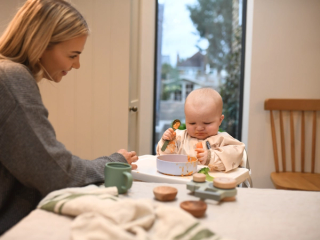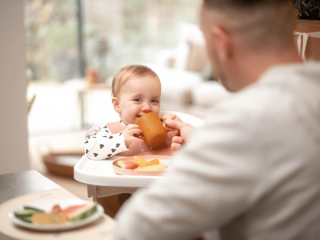
- Home
- Advice Hub
- Baby
- Weaning
- Moving On From Single Flavours To Mixed
Moving on from single flavours to mixed
After those initial tastes of bitter vegetables you can start to expand what you give so your baby can explore new flavours. There’s really no right or wrong here, but with a few key steps you can make sure you are offering a nutritious and varied diet.
Your baby’s first tastes of solid food can feel very emotional – it might be super exciting or maybe there’s anxiety over what to do. Some parents feel sad that their child is already at the stage of eating solid food – where does the time go?!
For the first week or two of weaning it is recommended that you offer green, bitter tasting vegetables to your baby as there is research to show this may help to increase their desire to eat vegetables. If you have already started and didn’t do this, don’t worry, it’s not going to have done any harm, it’s fine to start with other foods , but we would recommend you try to introduce these as soon as you can to help encourage their acceptance of these flavours.
After those initial tastes of bitter vegetables you can start to expand what you give so your baby can explore new flavours. There’s really no right or wrong here, so don’t worry too much about ‘getting it right’ but with a few key steps you can make sure you are offering a really nutritious diet and ensuring you are offering lots of opportunities to explore flavour too.
Moving on from vegetables
You can move onto other sweeter tasting vegetables such as sweet potato and carrots and fruits too. Once your baby has experienced a few days of single flavours and enjoyed exploring these you can think about moving on and exploring further.
Mixing flavours
Mixing flavours offers the opportunity for new flavour combinations, and can feel more ‘interesting’ to parents, but don’t feel you have to. It’s a good idea for your baby to get an idea of what single fruits and vegetables taste like as well as combinations. So single flavours work well all the way through weaning – if you think about it, we don’t mix all of our flavours together at mealtimes. Some meals we do, but there’s not many meals where we fully combine all flavours into a single mouthful! Even if you’ve moved onto mixed flavours, you may want to continue to offer new foods separately, so your baby can really explore those new tastes and textures.
Try not to sweeten
We are born with a strong desire for sweet flavours and you may see more enthusiasm when these flavours are offered. It can be tempting to start sweetening foods so your baby enjoys them more, but remember the more you sweeten foods, the more you will fuel that desire (the sweet tooth) and it can be hard to go back to plain savoury tastes once your baby has discovered their love for sweet. For example, plain porridge may taste very bland and boring to you, but that’s because you’ve had a lifetime of eating it sweet. Your baby doesn’t know any different yet!
Mixing food groups
As well as increasing flavours and trialling different combinations it is also important to start offering more food groups than just fruit and vegetables. Fruit and vegetables are good for us, but they don’t contain the range of nutrients that are needed for your growing baby.
What are the food groups ?
Fruits and vegetables: great for long term health and supporting regular bowel movements. There is nothing off limits in this group. Aim to eat the rainbow each day!
Dairy: milk, yoghurt and cheese provide calcium, for normal bone development. Foods from this group should be full fat and milk can be used in food but should not be given as a drink until 12 months.
Proteins: meat, fish, eggs, pulses nut butters etc. support normal growth and development of bones and provide a source of iron. When your baby first starts weaning, the vegetarian sources of protein are sometimes easier to eat as they tend to break down more during cooking so are easier to blend. If given as finger foods, they often take less chewing.
Carbohydrates: bread, rice, potato, pasta, noodles, yam etc provide energy, some nutrients and fibre. At the start of weaning, avoid very high fibre foods (e.g. foods with added bran or dark rye breads) as these can overwhelm the gut and cause constipation or loose stools.
How to build meals
An easy way to understand how to build savoury meals is to do the following:
- 33% foods with lots of iron – meat, fish, eggs, pulses or foods with added iron such as our baby porridge.
- 33% starchy carbohydrates
- 33% vegetables (having these present will help the iron to be absorbed)
If you follow this principle you will be giving your baby the best start to their eating adventures. Once your baby has reached the stage of having a second course, you can add the dairy group as a pudding. Or some meals work well with a spoonful of plain yoghurt on them too!
Not every meal will achieve the perfect balance, but if you can follow this guide for the majority of your little one’s meals it will help ensure they are getting good variety and nutrition.
Is under 1 just for fun?
There’s a phrase that makes its way around social media and parenting groups about weaning – under one is just for fun – and this can give the impression that the food isn’t really important. We’d like to put that rumour to bed now! Food should ALWAYS be fun, but that’s not all it’s about. Learning to eat different flavours and textures is important too – as is nutrition!
Advice & tips

Want to read more? Join the HiPP BabyClub for full access to this article.
As a BabyClub member, you'll get access to a range of exclusive benefits, including:
Monthly competitions
Discounts from our Partners
Expert advice tailored to your little one's age
Weaning recipes
HiPP shop discounts*
*10% off HiPP's online shop does not apply to our First Infant, Anti-Reflux or Comfort Formula Milk.
Important notice: Breastfeeding is best. Follow on milk should only be used as part of a mixed diet from 6 months. Talk to a healthcare professional.
















